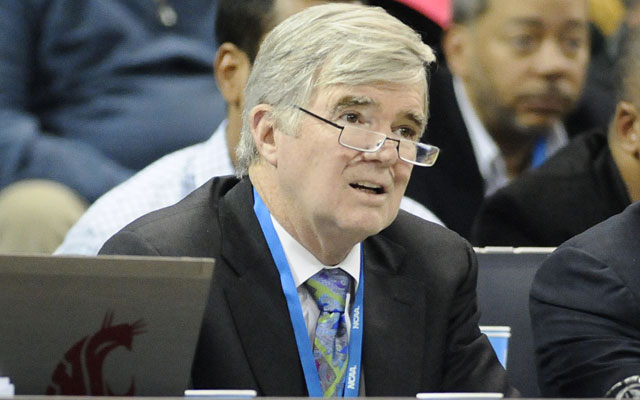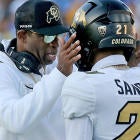
The agenda for the NCAA board of directors meeting has surfaced with a bit more detail on autonomy.
Gleaned from the 82-page document is a snapshot of what power the Big Five conferences will have and how they conceivably can use it. Restructuring, now, has become sort of a race to beat multiple lawsuits against the NCAA to court and also to defuse the unionization movement.
While all these principles, proposals and ideas were in place before Kain Colter spoke up, it is interesting to note: Thursday's board meeting in Indianapolis comes a day before the Northwestern players will vote on whether to unionize.
I've tried to edit this down. Wow, can these people run off at the keyboard! Example: The term "student-athlete" appears in the document 131 times. Best news: Most or all of these changes should be ready to implement by August.
We start with a definition of autonomy from the document itself. At intervals, I will add follow-up comments ...
The 65 member institutions of five conferences (ACC, Big Ten, Big 12, Pac-12, SEC), along with all other Division I members, envision an effective intercollegiate athletics system that fully meets the needs and expectations of student-athletes in the 21st century.
The 65 member institutions are committed to meeting the needs of student-athletes based on increased resources, and they desire to provide student-athletes with enhanced benefits such as full cost of attendance, lifelong learning and additional health and nutritional benefits. In addition, they desire to support student-athletes who are considering careers as professional athletes by providing more opportunities for that decision-making process to occur in a fair and fully informed manner.
These institutions are further challenged in addressing these needs by an increasingly litigious environment and confused public sentiment. They face the most public comment and criticism of all Division I institutions and conferences, often from advocates for pay-for-play or a professional athletics system for colleges and universities.
Comment: It's significant that the NCAA in this document admits to an "increasingly litigious environment" and says there is "confused public sentiment."
Guiding principles for autonomy
1. Engage and empower institutions and practitioners in a fully transparent decision-making process.
2. Engage and empower student-athletes by giving them both a voice and vote within a transparent decision-making process.
3. Ensure that regulatory change in these areas enjoys broad support among the 65-member institutions of these conferences.
The Steering Committee (made up of parts of the board) believes that the proposed autonomy system effectively addresses these principles, and is well-aligned with the student-athlete centered spirit reflected in the NCAA core ideology and revised Division I governance model.
Areas of autonomy for the Big Five conferences
The Steering Committee recommends that autonomous decision-making be granted to the ACC, Big 12, Big Ten, Pac-12 and the SEC, and their 65 member institutions.
• Permissive legislation -- Designed to allow permissive use of resources by any member to advance the legitimate educational or athletics-related needs of student-athletes. Under this proposed governance model, permissive legislation that is developed and adopted among these institutions and conferences may also be adopted by the rest of Division I at each institution's respective discretion, or as determined by its conference.
Comment: "Permissive" is a key code word here. NCAA officials have chosen it instead of "optional." If Idaho can't afford the full cost of attendance, then that's fine. A lot of this legislation will be optional. The thinking being, that if Idaho (just an example) can't afford a $6,000 cost of attendance bump like Ohio State, that's OK. That doesn't affect how they compete on the field.
• Actionable legislation -- Adopted and applied to the 65-member institutions to modify specified rules in a manner that enhances the student-athlete experience, or decreases athletics time demands or other burdens of student-athletes. These legislative changes that address student-athlete interests or experience will apply only to the five conferences and their 65-member institutions, although Division I members generally would be free to address the same or similar issues through legislation considered by the new Council ...
Comment: One of key issues the Big Five commissioners want addressed is time spent by athletes on their sport. The NCAA limits 20 hours per week. However, that regional National Labor Relations Board official used as his foundation for granting a union vote the conclusion that athletes spend 40-50 hours per week on their sport.
Amazingly, few have disputed that fact. Be assured those hours are going to be cut. The commissioners will see to it. No specifics yet but I'm thinking that some of those voluntary offseason workouts will pretty much be eliminated.
Financial Aid
Under the proposed system, the five conferences and their 65 member institutions will have the flexibility to revise the financial aid rules to increase the aid available to student-athletes in a way that is consistent with basic principles of amateurism and the collegiate model. The conferences will be granted flexibility to increase the maximum grant-in-aid (up to an amount commensurate with the full cost of attendance), as well as the ability to provide scholarships that will allow former student-athletes to complete their undergraduate education in appropriate circumstances.
Comment: This is the biggie. Referenced above, the cost of attendance is the difference between the financial aid package (room, books, board, tuition) and what it actually costs to live in a given college town. Southern California athletes will get more than those in Troy, Ala., because of the cost of living. That's OK because, once again, it doesn't affect them on the field.
Expenses and Benefits
The Steering Committee believes that the five conferences and their 65-member institutions are committed, in a manner consistent with the basic principles of amateurism and the collegiate model, to enhancing the support provided to student-athletes to meet legitimate needs. The proposed model grants autonomy to these institutions over rules such as awards and benefits, and those that have a direct impact on expenses incurred by a student-athlete and his/her family and friends that are associated with the competitive experience. Examples include, but are not limited to, expenses for receipt of awards, complimentary admissions, postseason travel for friends and family, expenses incidental to practice (e.g., parking), and other expenses in conjunction with practice and competition.
Comment: This one's real easy. A player's family (the scope of which is to be defined later) will be able to attend the NCAA Tournament, Final Four and bowl games. The Big Five will develop legislation to foot the bill. Seems like a no-brainer.
Expenses and Benefits (Pre-Enrollment Support)
In the proposed model, the five conferences and their 65 member institutions also would be granted autonomy over regulations addressing expenses and benefits provided prior to enrollment. These rules directly impact student-athlete welfare by permitting assistance to families who would like to visit universities, and who incur other legitimate expenses in connection with the recruiting process. Benefits in this area have the potential to ease a student-athlete's transition to college (e.g., medical expenses and academic support the summer prior to enrollment, transportation to enroll). Funding such pre-enrollment expenses would provide important support for student-athletes as they evaluate colleges and transition to the college environment.
Comment: In other words, schools will be able to pay for two parents (at least) to accompany a recruit on an official visit.
Insurance and Career Transition
The potential future professional athletics opportunities available to some student-athletes, who are disproportionately enrolled at the five conference's 65 member institutions, provide the basis for granting autonomy in rules permitting student-athletes flexibility in securing loans to purchase career-related insurance products (e.g., loss-of-value insurance), or to permit institutions to provide these insurance-related expenses for student-athletes ...
In the area of career transition, the five conferences and their 65 member institutions would be granted autonomy to redefine rules governing agents and advisors so that more assistance could be provided to student-athletes with career planning and decision-making.
Comment: Yep, you read that right. The Big Five will have the power to "redefine" what it means to interact with an agent. I talked to SEC commissioner Mike Slive about this earlier this month. He was the one who first put the idea out there. Slive is still not sure about the details but, to me, everything is on the table.
• Players could sign with agents and -- as long as no money changed hands while in school -- said agent could begin negotiating shoe and apparel deals for the future.
• At the very least, agents will be able to offer their professional expertise for those considering a professional draft. Currently, football players can receive a draft "evaluation" from a group of experts. That draft range sometimes isn't very precise.
• The language here at least gives hope to wiping the scourge of agent runners on campus.
Career Pursuits
In order to fully support student-athletes and their aspirations, the five conferences and their 65 member institutions would be granted autonomy to make changes to rules that hinder a student-athlete's career pursuits unrelated to athletics (e.g., restrictions on a student-athlete promoting his or her musical career). Again, it is believed that these modifications can be made without violating basic principles of amateurism and the collegiate model.
Comment: This is common sense. A couple of years ago, a Minnesota wrestler gave up his eligibility because he refused to change his given name on tunes he had posted on YouTube.
Really. He would have been eligible if he called himself "MC Funky Gopher" instead of the name on his scholarship. That's silly. Let a kid develop his skills or interests outside of his sport.
Time Demands
Given the visibility and demands associated with meeting expectations existing for highly-competitive intercollegiate athletics programs, the five conferences and their 65 member institutions would be granted autonomy to update rules and policies governing time demands in order to permit a more appropriate balance between athletics and other student-athlete activities. This updated approach is intended to reconstruct the time boundaries associated with student-athletes' commitment to intercollegiate athletics. In addition, design and implementation of "athletic dead periods" for student-athletes would be intended to foster their participation in educational opportunities outside of intercollegiate athletics.
Comment: Wait, you mean players could go to the local art museum instead of get together for "voluntary" 7-on-7? Get outta here.
Eligibility
The five conferences and their 65 member institutions have not specifically requested academic eligibility requirements as an area for autonomous decision making, and are committed to the Division I shared governance rules in this area. However, attention associated with transfers falls disproportionately to the five conferences and their 65 member institutions, which under the new system would be granted autonomy to modify transfer policies that would provide appropriate flexibility for unique circumstances to address the best interests of student-athletes. Any changes to transfer policy will only be within the five conferences and their 65 member institutions and will not affect other schools and conferences without their approval.
Comment: Anything that takes away the byzantine NCAA rules makes sense. Mark Emmert admitted Friday on ESPN that some athletes choose their school based on what kind of offense a coach runs. That kind of admission is a start. If a coach leaves for another job, why can't an athlete have more freedom to transfer?
Recruiting
The five conferences and their 65 member institutions would be granted autonomy to revise and establish rules as necessary to address concerns related to the infringement of recruiting activities on prospective student-athletes' academic preparation.
Personnel
Numerous issues, including proliferation of non-coaching personnel, varying titles associated with certain coaching positions, and the breadth of approach to personnel issues present in Division I, combine to establish the need for the five conferences and their 65 member institutions to be granted autonomy to both revise existing personnel definitions and limits, and to establish policies intended to meet the support needs of teams while properly structuring the number of personnel directly or indirectly associated with each sport in a manner consistent with the need for competitive balance.
Comment: One coach last season called them "polo shirts," the seemingly endless number of support staff on the Alabama sideline. This language seeks to address that issue.
Football is allowed only nine assistants and various support staff. We know in this modern world that some high-end programs employ what they call "analysts" who do nothing but break down film of recruits, then pass it up the chain to an assistant for further evaluation.
Too much? We'll see.
Autonomy Voting Process
Autonomy Defined: Autonomy allocated to the five conferences ... shall mean [they] are afforded independent decision-making authority through a process intended to ensure institutional participation, which results in final decisions on specified matters ...
Vision: Inherent in the autonomy system is a vision and commitment to define the full grant-in-aid as meeting a student-athlete's full cost of attendance, and the provision of a lifetime opportunity to fund the undergraduate education of current and former student-athletes. The ability to provide these student-athlete benefits shall be identified within an initial Agenda for Change and shall be addressed during the first business session of the five conferences and their 65 member institutions in 2015.
Enfranchised Decision-Making: The five conferences' decision-making process is intended to improve relationships between and among their 65 member institutions and student-athletes who have spoken clearly about their feelings of disenfranchisement within the current regulatory model. In that regard, student-athletes will participate with an independent vote and voice at all levels ...
There shall be 80 total votes (65 institutional and 15 student-athlete) ... Two/thirds of the group of 80 and four-out-of-five conference approval by simple majority within conferences.
Business Session: A Five-Conference Business Session shall be conducted at least annually. Each of the 65-member institutions shall appoint representatives to attend and participate in the business session.
Division I Board and Council
Five-Conference Forum: A Five-Conference Forum shall be conducted annually prior to the business session. The Five-Conference Forum shall be a town hall meeting open to each member institution's president or chancellor, faculty athletics representative, athletics director, senior woman administrator and student-athlete representatives. Commissioners and staff from five conference offices also shall participate in the forum, along with other invited participants, which shall include coaches.
The forum agenda shall include:
• Autonomous issues, including proposed changes;
• Shared governance issues;
• Current topics in intercollegiate athletics; and
• Other items deemed appropriate.
Override: Decisions made through the autonomy system shall be final and not subject to override
Comment: Will the media be invited to this town hall meeting?
.... The Steering Committee agreed that the process to expand the autonomy categories must be transparent and robust.
Comment: Sounds like a yes.




















